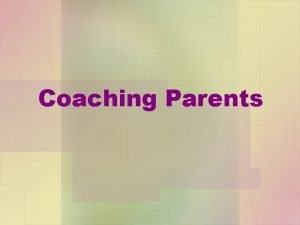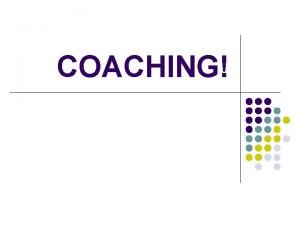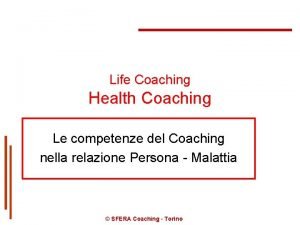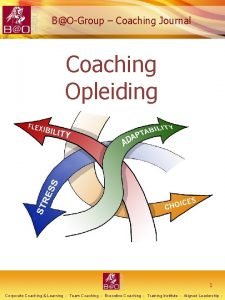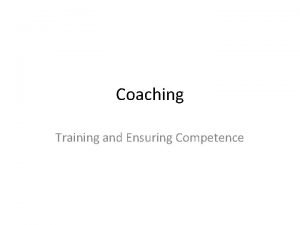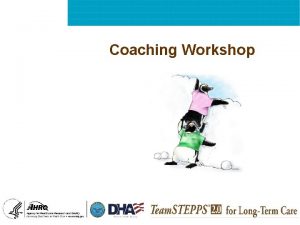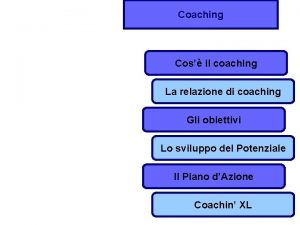YOU 3 You Coaching Process The Need for








- Slides: 8

YOU 3 You Coaching Process

The Need for Coaching in India According to The Leadership deficit: Gaps in leadership pipelinethe biggest HR challenge (The Economic Times, 2010), “It seems that Indian corporates need more leaders, better leaders and they need them fast. ” By building a coaching culture, organizations can address this deficit. 1. "We are not built to grow our talent pool fast enough to feed our business growth" üCoaching enables the self-direction and accelerated development of existing talent pool 2. "We are expanding globally and need to find the talent to run cross-cultural operations" üCoaching builds the manager’s ability to develop strong relationships and communicate effectively across cultures 3. "We have solid technical experts but we can't convert them into business leaders“ üCoaching builds the manager’s ability to empower and inspire teams, helping transform technical experts into business leaders 4. “We don’t have enough emerging leaders to replace them“ üCoaching helps the leadership team develop the next generation of leaders *As featured in The Economic Times

The Need for Coaching in India Since 1999, The Conference Board CEO Challenge survey has asked CEOs, presidents, and chairmen across the globe to identify their most critical challenges for the coming year. The five top challenges selected by the 776 respondents to this year’s survey— Innovation, Human Capital, Global Political/Economic Risk, Government Regulation, and Global Expansion—show a balance between concerns related to the macro business environment (of which business leaders have limited or no control individually) and company-specific challenges that are driven by management action and require a well Executed business strategy. Human Capital is the second-ranked critical challenge for CEOs, especially the need to develop internal talent. The three top-ranked strategies (grow talent internally, improve leadership development programs, and provide employee training and development) involve actions to develop and retain employees within a company. Human Capital is the number one challenge in both China and India, where shortages of highly skilled talent and inflated wagescomplicate the operating environment and frustrate growth plans.

Coaching Defined • Coaching is applied leadership. So a good coach is “someone who has been there” • Focus in coaching is to inculcate habit of competing with oneself continuously and the self belief that the best means of growth come from within • A coach evokes excellence in the person by being a “catalyst” or a “thought partner” in the joint exploration process. • Coach is a detective of good things /positives. • Coaching focuses on future possibilities not past mistakes. • T. Gallwey author of Inner Game has a formula:

Coaching 7 S Framework SELF AWARENESS & Self belief STRATEGY SUPERORDINATE Self actualization GOALS SYSTEMs &Responsibili ty STYLE SKILLS SELF Renewal & correction

Our Unique Leadership Coaching Model • The Customised Coaching Process §Understanding the client through multiple assessment tools §Evolve mutually agreed coaching goals and expectations of the coachee & the sponsors - applying the 80 -20 rule to set priority goals §A variety of indoor/outdoor interactions, dialogue, role plays, cases and examples relevant to the goals of the coachee • The intersection of three circles in Trimurthi / Trinity model §Capabilities of the leader: Business acumen, People acumen and Cognitive Bandwidth §Role of a Leader: Tasks, Teams and Own Motivational needs §Tools of Leadership: Concepts, Communication Abilities and Connections

Our Unique Leadership Coaching Model • Envisions the Trimurti leader with the balance of three major facets of leadership— the 3 in 1 Hindu Godhead comprising Brahma the Creator, Vishnu the Preserver and Shiva the Destroyer/Changer of the old order • Customised solutions based on contexts unique to Coachee • Building of Unique Coachee – Coach Relationship §Uniqueness of both the client and coach is synergised through free exchanges §Atmosphere of openness and trust to develop a mutually rewarding relationship §Basic Philosophy - “You can’t teach any one anything, you can only create conditions in which he learns or doesn’t. ”

. . The Coaching contexts • Four coaching roles –for skills , for performance, for development and for executive agenda[ ie learning that is related to an executive agenda which inturn could be directly linked to Company strategy. • The multiple benefits of coaching : Improved performance & productivity , staff development , improved learning , improved relationships , improved quality of life , more time for the manager , more creative ideas, better use of people , skills and resources, faster and more effective emergency response, greater flexibility and adaptability to change , more motivated staff , culture of change , a life skill. • Contexts : Ideal when the person feels “stuck –Burnt out – Bored out “, routine is disturbed, /interrupted, change in circumstrances , organisational needs , breakddowns , broken promises etc
 I wish you all the strength
I wish you all the strength Split direct speech worksheet
Split direct speech worksheet Iso 22301 utbildning
Iso 22301 utbildning Typiska drag för en novell
Typiska drag för en novell Nationell inriktning för artificiell intelligens
Nationell inriktning för artificiell intelligens Ekologiskt fotavtryck
Ekologiskt fotavtryck Varför kallas perioden 1918-1939 för mellankrigstiden
Varför kallas perioden 1918-1939 för mellankrigstiden En lathund för arbete med kontinuitetshantering
En lathund för arbete med kontinuitetshantering Personalliggare bygg undantag
Personalliggare bygg undantag









